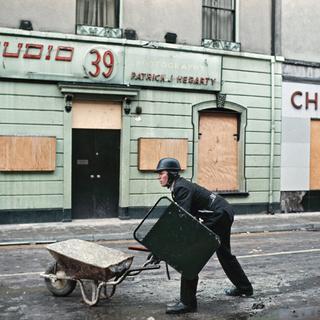


Akihiko Okamura, a Japanese witness to a torn Ireland
GalleryLiving in Ireland in the 1970s, Japanese photographer Akihiko Okamura covered the Northern Ireland conflict. Sensitive to the Catholics' pro-independence aspirations, he observed these events without being noticed. His poetic, offbeat view of this violent period has now been rediscovered in a new book.
Glass milk bottles lined up on a doorstep, laughing children making a straw man before a parade, an abandoned sofa in the middle of a street with blackened facades – these are not the kind of images you have in mind when you think of the Northern Irish conflict, which claimed over three and a half thousand lives between the late 1960s and the 1998 peace accords.
Instead, the violent clashes immortalized in black and white by famous photojournalists such as Don McCullin or Gilles Peress in the early 1970 have remained etched in our memories. The contemplative Kodachrome images by Akihiko Okamura (1929-1985), bathed in melancholy colors, offer an offbeat look at the troubles that pitted loyalists (Protestants) loyal to Great Britain against nationalists (Catholics) opposed to the British presence and in favor of Irish reunification. These images exude a strange mystery, as great as that surrounding their creator.
The only Japanese to cover these bloody events, this photographer in love with Ireland, with a heart rooted in the left and sensitive to the Catholic republicans' anti-colonialist demands, had even decided to live there. Settling with his family south of Dublin in the Republic of Ireland in 1969, he stayed for over 15 years, surveying both the independent south of the island and the British north, with its Catholic and Protestant districts in Derry and Belfast, photographing political leaders from both camps. But no one on the spot seems to have kept any memory of his activity, as if Okamura had passed through the events as an invisible man.
Little-known clichés
His reports from the heart of the Vietnam War, published in Life magazine in 1964 and 1965, had already made him a household name. His pictures taken in Ireland on the other hand, have remained little-known, and for the most part unpublished. It took an exhibition at Dublin's Photo Museum Ireland this summer and a book, The Memories of Others (Atelier EXB, 160 pages), edited by photographic historian Pauline Vermare, who wrote her thesis on photographic representations of Northern Ireland, to bring recognition to this original, sensitive approach.
Although Okamura followed the riots in Derry's Bogside district in 1969, he never photographed the violence directly. Instead, he hinted at it in small, poetic compositions of calculated ambivalence. These innocent white milk bottles, for example, became weapons when transformed into Molotov cocktails.
Okamura's main interest was in the way in which everyday life and war collided, often in bizarre ways: Residents watching the clashes from their windows and a soldier's kit, which included a packet of cookies, as well as a riot shield. He favored wide shots, concentrating on the aftermath or the moment after, like the traces of blood and flowers that marked the spot where a young man was killed by British soldiers in Derry in 1971.
You have 19.02% of this article left to read. The rest is for subscribers only.
